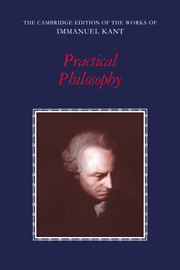Book contents
- Frontmatter
- Contents
- General editors' preface
- Preface
- General introduction
- Review of Schulz's Attempt at an introduction to a doctrine of morals for all human beings regardless of different religions (1783)
- An answer to the question: What is enlightenment? (1784)
- On the wrongfulness of unauthorized publication of books (1785)
- Groundwork of The metaphysics of morals (1785)
- Review of Gottlieb Hufeland's Essay on the principle of natural right (1786) [translated and edited by Allen Wood]
- Kraus's review of Ulrich's Eleutheriology (1788)
- Critique of practical reason (1788)
- On the common saying: That may be correct in theory, but it is of no use in practice (1793)
- Toward perpetual peace (1795)
- The metaphysics of morals (1797)
- On a supposed right to lie from philanthropy (1797)
- On turning out books (1798) [translated and edited by Allen Wood]
- Editorial notes
- Glossary
- Index of names
- Index of subjects
On the common saying: That may be correct in theory, but it is of no use in practice (1793)
Published online by Cambridge University Press: 05 June 2012
- Frontmatter
- Contents
- General editors' preface
- Preface
- General introduction
- Review of Schulz's Attempt at an introduction to a doctrine of morals for all human beings regardless of different religions (1783)
- An answer to the question: What is enlightenment? (1784)
- On the wrongfulness of unauthorized publication of books (1785)
- Groundwork of The metaphysics of morals (1785)
- Review of Gottlieb Hufeland's Essay on the principle of natural right (1786) [translated and edited by Allen Wood]
- Kraus's review of Ulrich's Eleutheriology (1788)
- Critique of practical reason (1788)
- On the common saying: That may be correct in theory, but it is of no use in practice (1793)
- Toward perpetual peace (1795)
- The metaphysics of morals (1797)
- On a supposed right to lie from philanthropy (1797)
- On turning out books (1798) [translated and edited by Allen Wood]
- Editorial notes
- Glossary
- Index of names
- Index of subjects
Summary
On July 30, 1792, Kant wrote to Johann Erich Biester, editor of the Berlinische Monatsschrift, requesting that he return “as soon as possible” a manuscript, the four parts of which were to have appeared in four successive issues of the journal (AK 11:336). The manuscript was eventually published as Religion within the Boundaries of Mere Reason. Biester had obtained the Berlin censors' imprimatur for the treatise that became Book I of Religion but, despite his appeal from their decision, had been firmly denied permission to publish the treatise that became Book II. As Kant pointed out, the first treatise, without the others, could cut an “odd figure” in the journal. In place of it he offered to provide a strictly “moral” treatise, dealing with Christian Garve's criticism of Kant's moral principle in Part I of his Essays on Various Topics from Morals, Literature and Social Life (1792).
The treatise, as Kant first described it, never appeared. Instead, the reply to Garve became Part I of Kant's essay “On the Common Saying: That May Be True in Theory, but It Is of No Use in Practice,” which was published in the Berlinische Monatsschrift in 1793. Since Garve's criticism was, in part, that Kant's formal principle could not provide a motive for action, it could well be brought under the “common saying.” So too could Kant's contention against Hobbes, in Part II, that subjects have noncoercive rights against their sovereign, and his objection, in Part III, to Moses Mendelssohn's view that the human race will never make moral progress. As to why Kant chose to focus on this common saying and extend it, there is no hard evidence.
- Type
- Chapter
- Information
- Practical Philosophy , pp. 273 - 310Publisher: Cambridge University PressPrint publication year: 1996
- 50
- Cited by



